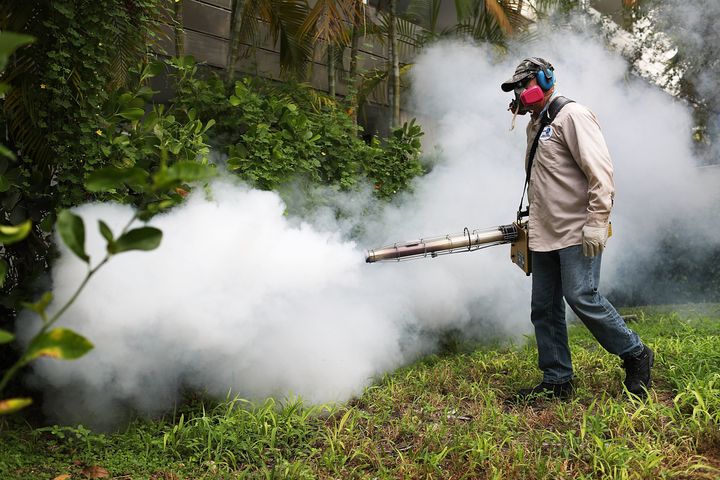
To fight mosquitoes that may be carrying the Zika virus, officials in Miami-Dade County are now using aerial spraying, and this is stirring local controversy about the safety of the chemicals that are used in those sprays.
The debate is over a pesticide called naled, which has been registered for use by the Environmental Protection Agency since 1959. The insecticide has been banned in Europe since 2012, however, which has made some locals nervous.
The European Union classifies naled as harmful to aquatic life, dangerous if swallowed and harmful if it comes in contact with the skin. However, the effects of any chemical greatly depend on the amount that is used, said Keith Solomon, a professor emeritus at the University of Guelph in Canada, who researches environmental toxicology. [5 Things to Know About the Zika Virus]
“Obviously, people have to [apply it] properly,” to the environment, Solomon told Live Science. “But as long as you put it on properly, there’s not going to be an excess risk to humans.”
Naled is part of a family of pesticides called organophosphates. It works by inhibiting enzymes found in animals called cholinesterases, particularly one called acetylcholinesterase, which is crucial to the transmission of nerve signals. Mosquitoes absorb the toxin through their skin, Solomon said, and die rapidly of paralysis and respiratory failure.
In high enough concentrations, Naled can cause nausea, dizziness, confusion and even convulsions and death in humans. But according to the Centers for Disease Control and Prevention, these effects require exposure to naled at far higher levels than licensed professionals dispense during spraying. Aerial spraying of naled is done in ultralow volumes — approximately an ounce, or two tablespoons, are sprayed per acre of land. The pesticide also breaks down quickly in the environment. A 1996 study in the Journal of the American Mosquito Control Association found that naled sprayed on filter paper and placed in sunlight outdoors had a half-life of just over an hour, meaning that half the substance degraded in that time period.
In a 2008 study of naled spraying that was also published in the Journal of the American Mosquito Control Association, researchers asked 205 people to provide urine samples before and after an ultralow-volume naled spray in their area of Florida. The researchers found that the participants were actually less likely to have components of naled in their urine after the spray, suggesting two things: One, that aerial spraying of naled doesn’t result in elevated levels of the chemical in the human body, and two, that some of the participants had probably been exposed to naled before the study started, perhaps from pest control chemicals used in their homes or workplaces.
Humans have a much lower ratio of body surface area to body volume than insects, and human skin is less prone to absorb naled than insects’ outer coverings, Solomon said. In comparison, he said, “The risks of Zika, at least in pregnant women, are pretty serious.”
The virus attacks the nervous system of a developing fetus and can cause severe birth defects, according to the CDC. The most visible is microcephaly, a condition in which the infant’s brain and skull are abnormally small, leading to severe developmental disabilities.
Researchers recently reported in the journal Radiology that some babies born to Zika-infected mothers may also have less obvious brain defects, including enlargement of the fluid-filled ventricles in the brain and abnormalities in the corpus callosum, the nerve bundle that connects the two sides of the brain. [Top 5 Ways to Reduce Toxins in Homes]
According to the Environmental Protection Agency, naled is used regularly across about 16 million acres in the United States and has also been used in targeted anti-mosquito efforts after hurricanes in Florida, Louisiana, Mississippi and Texas. Miami-Dade county is currently conducting aerial sprays in Miami Beach in the early-morning hours. Officials are also using trucks to spray a larvae-killing bacterium called BTI.
Europe’s stricter regulatory climate shouldn’t be taken as evidence that naled is unsafe, Solomon said. The European Union operates according to the precautionary principle, meaning that “where scientific data do not permit a complete evaluation of the risk, recourse to this principle may, for example, be used to stop distribution” of a product that is thought to be dangerous. In the United States, actual harm must be demonstrated to get a product off the market. Europe also bans aerial spraying altogether, Solomon said.
Original article on Live Science.
Editor’s Recommendations
Copyright 2016 LiveScience, a Purch company. All rights reserved. This material may not be published, broadcast, rewritten or redistributed.
